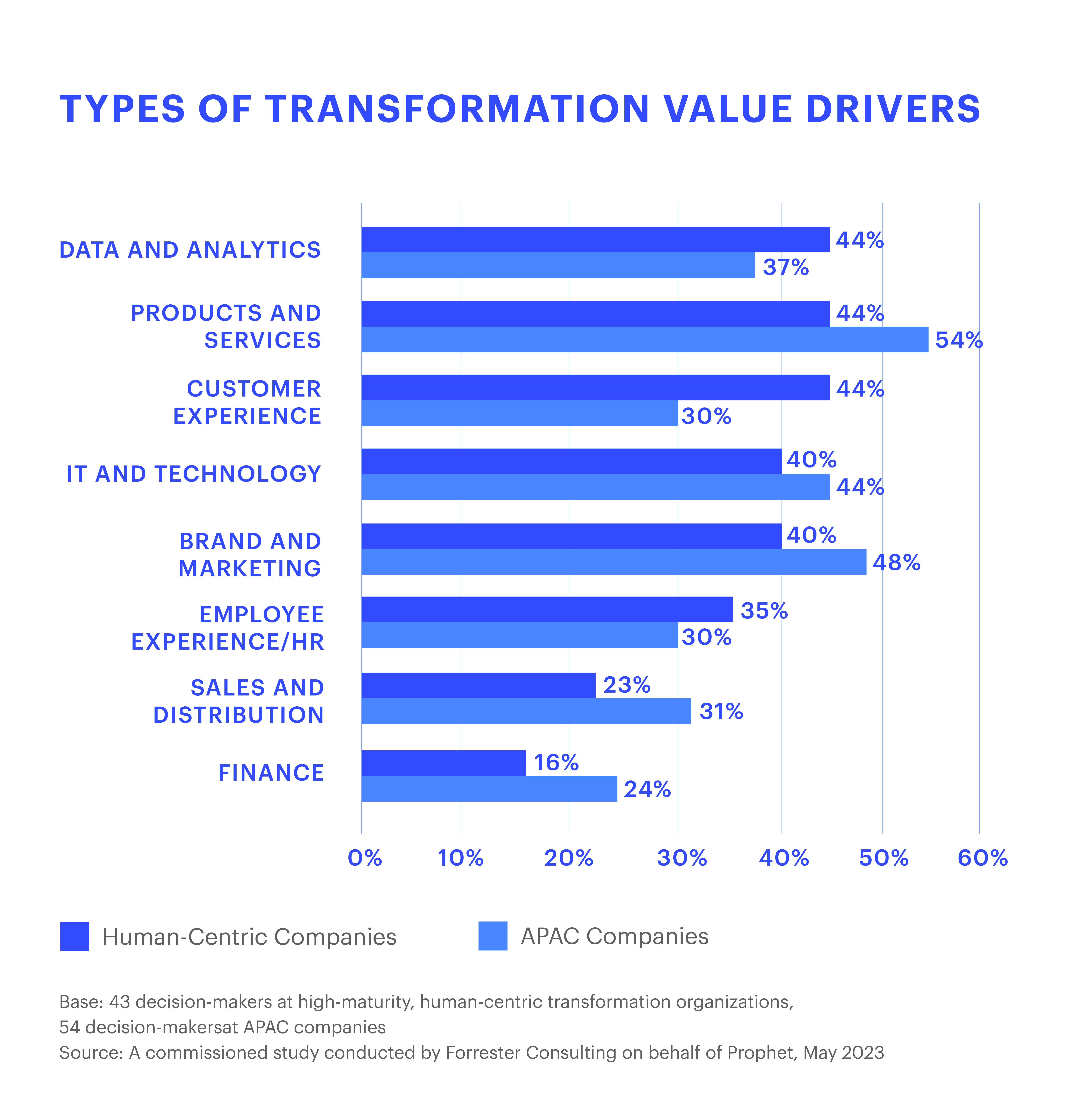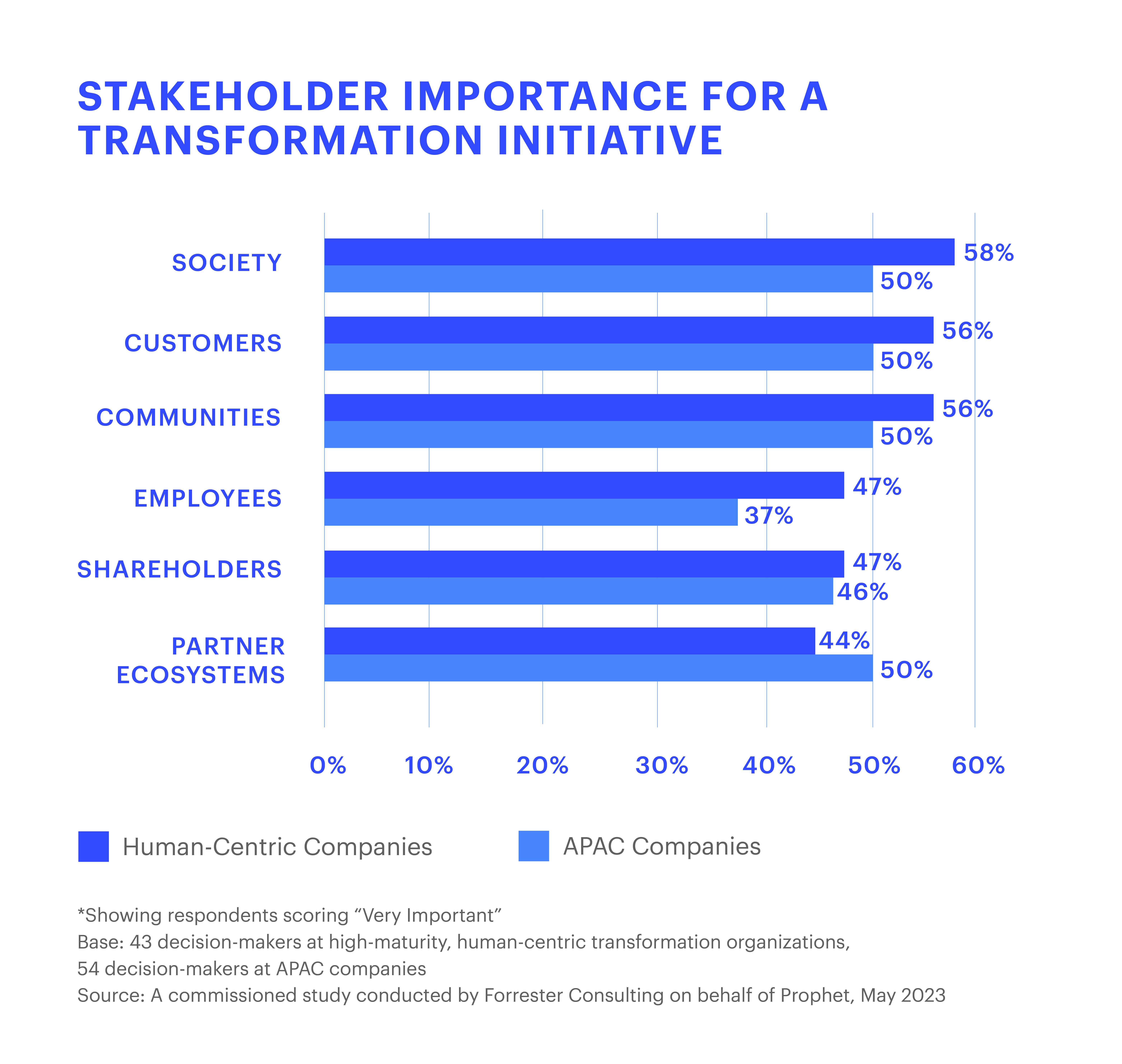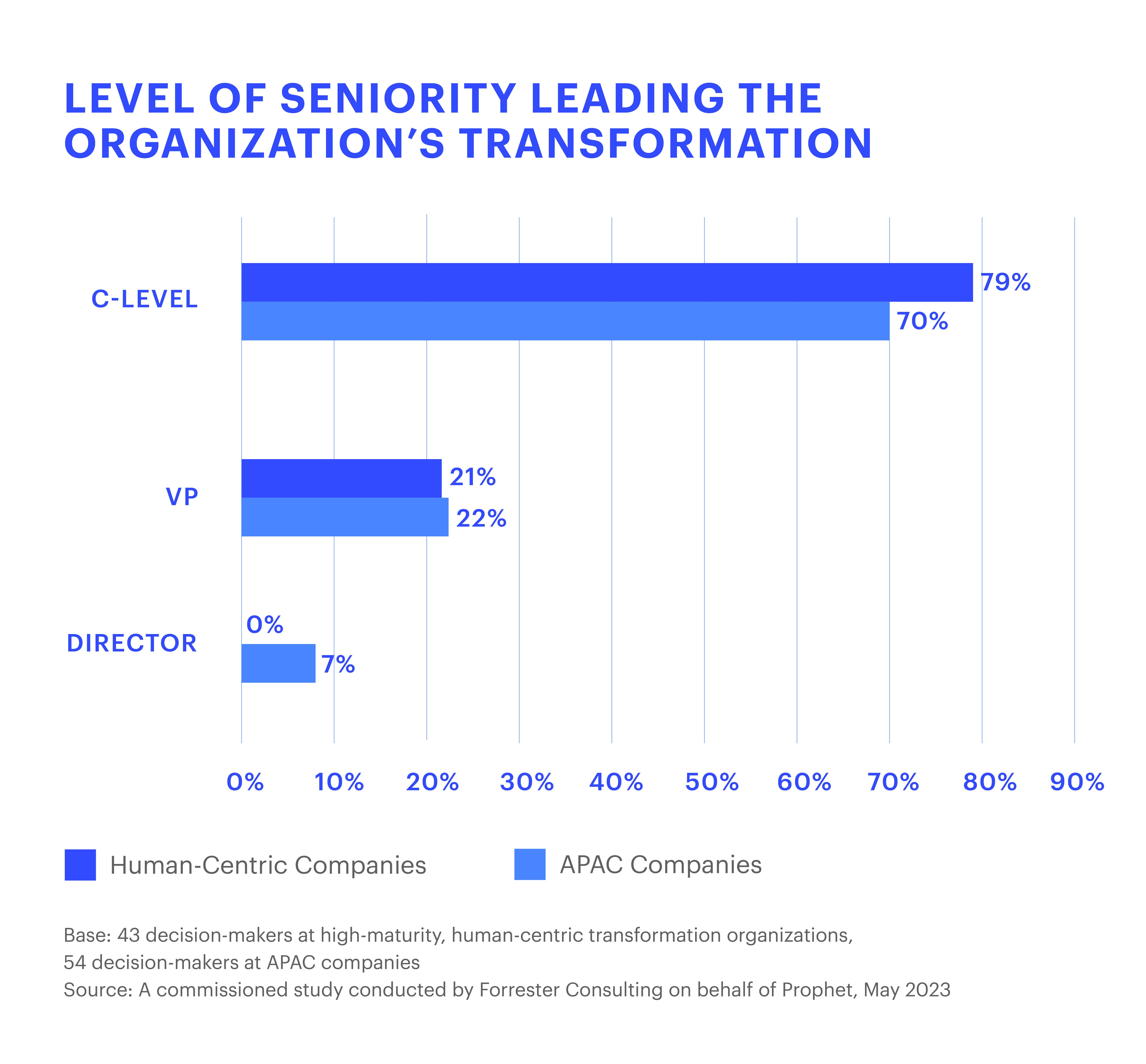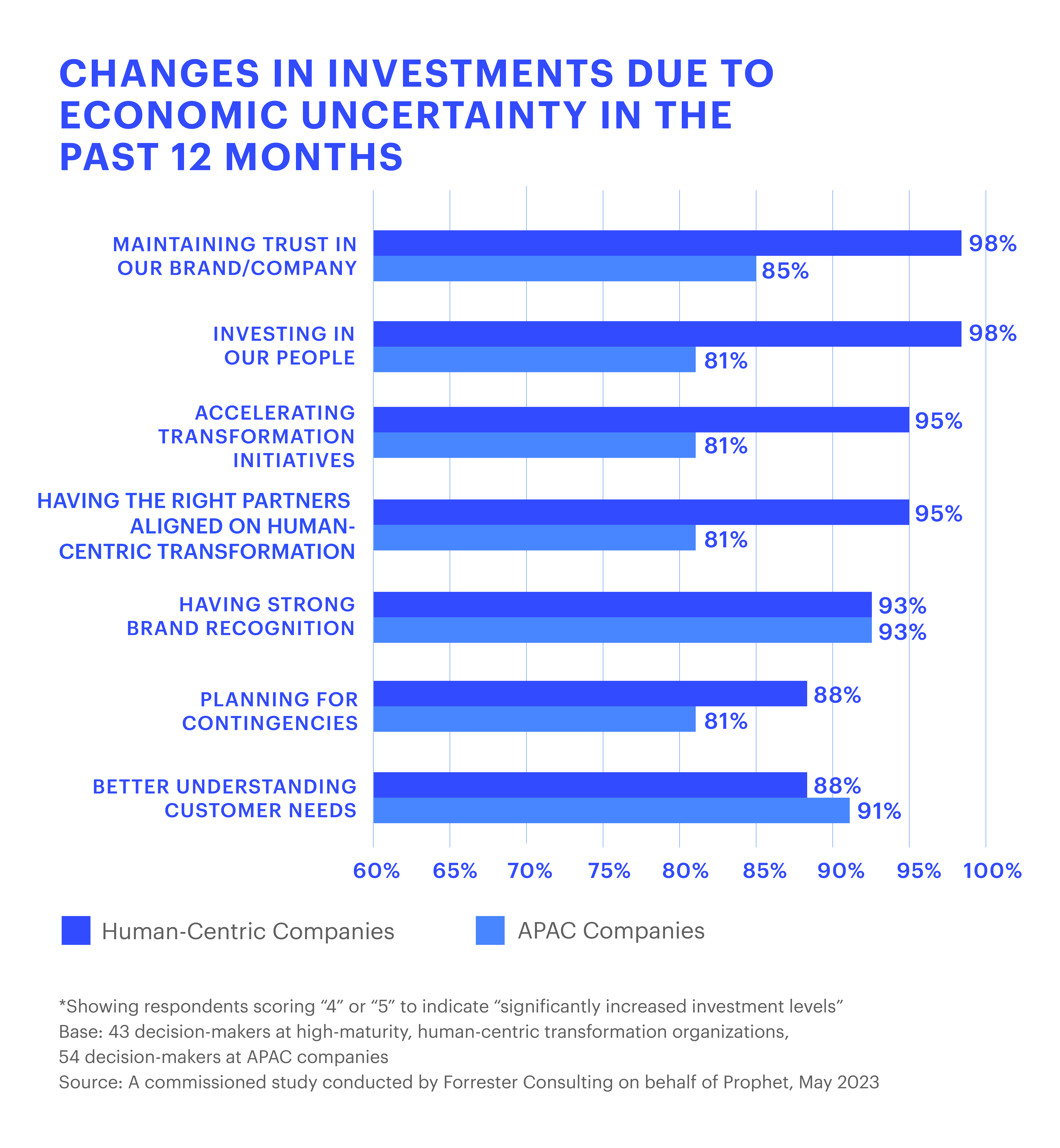BLOG
Four Imperatives for APAC Companies to Drive Human-Centric Transformations
Our global study showed organizations in APAC often prioritize technological and revenue-driven initiatives. Here we explore how human centricity leads to successful transformations.
Our latest commissioned global research study conducted by Forrester Consulting on behalf of Prophet explored how “human-centric” organizations use human-aligned change management principles to design transformation initiatives and align their business strategy around the human. We have found that human-centric companies are more likely to see results from their business transformation efforts. In fact, human-centric organizations are 10 times more likely to achieve revenue growth rates of 20% or more. Moreover, these organizations experience a remarkable 25% boost in employee collaboration, a significant 23% increase in shareholder value, an impressive 48% improvement in time to market, and a substantial 28% higher likelihood of pioneering groundbreaking innovations, among other remarkable statistics.
We believe these findings underscore the profound impact of human centricity, which involves prioritizing people, culture, and empathy within the context of organizational transformation. By doing so, organizations can harness the benefits of enhanced collaboration, increased shareholder value, and sustainable change, ultimately positioning themselves for growth and resilience in today’s fiercely competitive business landscape.
Embracing Human-Centric Transformation: The 4 Pillars of Success
In the dynamic business landscape of the APAC region, achieving substantial growth requires consistent strategic recalibration. Our research showed that driving long-term transformational growth requires a shift in focus from operations- and revenue-driven objectives to ones that prioritize the needs and experiences of their customers and employees.
In this article, we identified four key areas of how companies can embrace human-centric transformation through a multifaceted approach.
1. Enhance Customer Experience (CX) by Better Capturing and Predicting Customer Needs
Our research underscores a strong focus on high maturity and human-centric companies on understanding consumers through data and analytics and improving customer experience (CX). These transformation value drivers are among the top three priorities for close to half (44%) of the high-maturity respondents.
However, it is a very different scenario for APAC companies – there is a predominant focus on products and services (54%) rather than a broader consideration of CX (30%).
Hence a key opportunity for Asian businesses is to pivot their transformation drivers towards enhancing CX by harnessing the power of data analytics.

Nevertheless, there are pioneers in China who already embed human centricity in their core business strategy. NIO, a prominent player in the electric car industry, stands out as a prime example of a holistic and human-centric approach to its business. The company takes pride in its user-first operation model, placing an unwavering focus on creating long-lasting touchpoints and pleasant experiences across the customer life cycle. One of NIO’s leading innovations is its Power Swap Station which provides users with battery swapping as an alternative to conventional charging. NIO decided to invest in establishing and operating the service on its own, instead of using a third-party provider, in order to maintain the highest customer satisfaction. “User service may show a loss in financial statements, but it can also be interpreted as an investment in customer satisfaction, which I think is the more appropriate perspective,” said Lihong Qin, President of NIO.
2. Embracing Purposefulness as a Cornerstone of Brand and Culture for Employee and Customer Engagement
Purpose is more than a buzzword; it is a strategic imperative. Those who embrace this approach are well-positioned for success in the human-centric era. Companies around the world are increasingly recognizing the importance of anchoring their brand identity and organizational culture around a clear purpose to engage both employees and customers effectively.
According to our research, 56% of human-centric firms globally firmly believe that their culture enables purposefulness in everything they do (compared to 44% in APAC), which shows that those who operate with a clear purpose tend to excel in their transformation endeavors. However, many APAC companies making strides in commercial performance and technological innovation often deprioritize fostering purposefulness with a human-centric lens. Moreover, compared to global counterparts, only 50% of APAC companies strongly consider “society”, “customers” and “communities” as very important transformation initiatives, while only 37% prioritized “employees”.

Companies in the APAC region have a significant opportunity to strengthen their approach to transformation by defining a clear purpose and applying it to everything that they do. This involves shifting the focus to not only placing a greater emphasis on consumer experience but also broadening the lens to fostering a human-centric culture both internally and externally. It is crucial to align employees with the company’s purpose by developing a clear Employee Value Proposition (EVP) and effective employee engagement programs. Additionally, companies must consider the societal implications of business actions and Environmental, Social, and Governance (ESG) principles to create a more profound and sustainable impact.
Sea, a Singapore-based tech company and holding company of Shopee serves as a compelling example of how purpose can be seamlessly integrated into an organization’s human-centric culture. Sea’s overarching mission is to enhance lives and build more connected communities through technology. As it grows, Sea remains committed to nurturing the growth of the broader digital ecosystem and helping achieve digital inclusion for various local stakeholders who are underserved. For example, Shopee, one of the largest global e-commerce platforms, drives e-commerce access to local communities across hard-to-serve regions while also enabling local SME entrepreneurs to succeed. From launching a variety of training programs and platforms like Shopee University and Shopee Seller Center to working with local governments to establish local e-commerce hubs, the firm actively supports local communities to accelerate their digitization journey and grow their businesses. By embracing purposefulness through business initiatives, Sea’s mission transcends boundaries, benefitting all its stakeholders which include consumers, small businesses, local communities and employees.
3. Empowering C-Level Transformation Leadership
Another key finding from our research resonates clearly – human-centric transformations are most likely to thrive and yield tangible results when guided by C-level management who leads through their own actions. 79% of human-centric organizations have C-level leaders who lead their company’s transformation agenda, while only 70% of the APAC companies reported the same.

Human-centricity goes beyond just lines of mission statement, it should be translated into tangible actions within the organization. Hence there is a need for a more direct and hands-on stewardship from C-level executives in APAC to drive crucial transformation initiatives forward.
A striking illustration can be found in Ping An, a leading financial services company in Asia, which experienced a threefold increase in digital users over the past five years and doubled its retail customer base. Ping An made the strategic appointment of Jessica Tan as CIO in 2013, who was later promoted to co-CEO in 2018, to play a pivotal role in architecting Ping An’s business transformation into an innovation-driven business. Tan’s leadership brought importance to innovation and a forward-thinking approach, launching various industry-leading initiatives across fintech, healthtech and AI-based offerings. Ping An has invested RMB100 billion over the past decade and committed to investing twice that over the next five years. It now ranks 7th in the Forbes Global 2000 and is the largest insurance company in Asia today.
The Ping An example serves as a testament to the transformative potential of C-level leaders who actively lead by example, underscoring the importance of leadership in driving human-centric transformation and fostering a culture where technology and innovation thrive through collaboration across teams.
4. Building Internal and External Trust in the Brand
Driving near-term revenue growth by enhancing brand recognition and consumer insights is indeed important for an organization to survive in this unpredictable economy. However, the key to achieving sustainable growth is through transformation that is truly human-centric, which requires making focused and consistent investments in building both internal and external brand trust.
Our research indicates that amid the fervor for technological progress, investments in human capital development and brand trust often find themselves on the back burner among APAC companies. In fact, 98% of human-centric companies globally are investing to maintain trust in their brand while only 85% of APAC companies are doing so. APAC companies are also investing less in their employees as compared to human-centric companies (81% vs 98%).

Gojek is a powerful example of the paramount importance of maintaining a steadfast commitment to social impact and brand trust, even when confronted with the challenge of plummeting share prices. Gojek’s continuous investments in initiatives designed to support financially vulnerable riders and drivers, and its commitment to sustainability goals exemplify a forward-thinking approach. For example, recognizing that many drivers prefer greater flexibility and freedom, Gojek continues to update its daily incentives scheme like its Monthly Loyalty Rewards program which allows drivers to have more stable and sustainable earnings. By showcasing such a strong commitment to the community, this approach can significantly elevate internal brand loyalty, build external trust and maintain unwavering resilience, even amidst the most turbulent economic storms.
FINAL THOUGHTS
As the region continues to evolve, those that lead with purpose and resilience will thrive and make a lasting impact on the world of business. Shifting focus from operations- and revenue-driven objectives to ones that truly prioritize the needs and experiences of customers and employees will give organizations a higher ground. Through the above four pillars, there are opportunities to be more human-centric and achieve successful business transformation.
